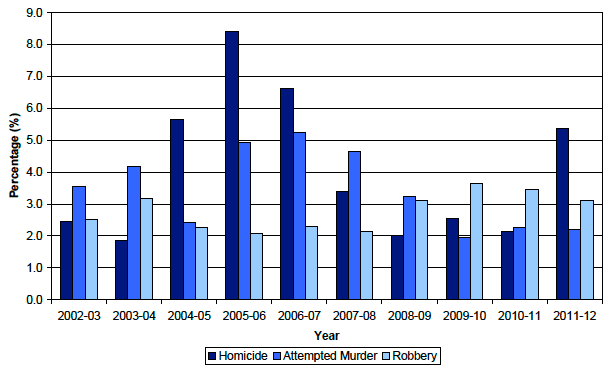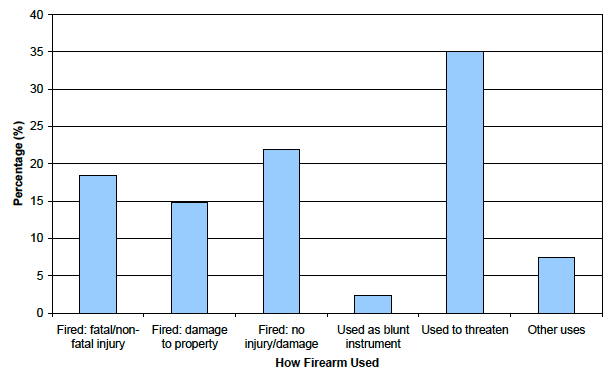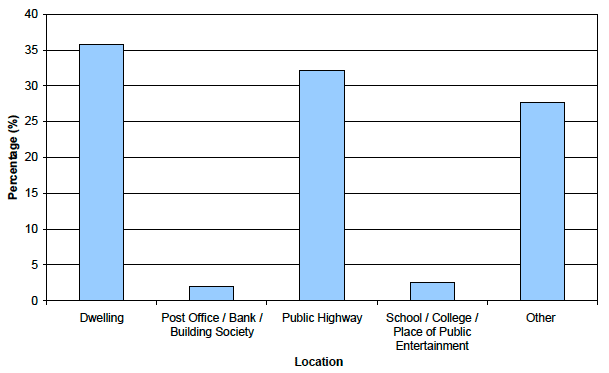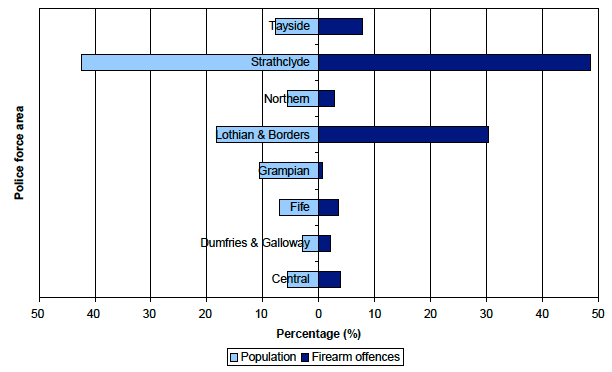Recorded Crimes and Offences Involving Firearms, Scotland, 2011-12
Statistical bulletin on crimes and offences involving firearms recorded by the police in Scotland in 2011-12
This document is part of a collection
3. Commentary
Minor Firearms Act 1968 offences (mainly relating to the possession, handling and distribution of weapons and ammunition) are not included in the main tables of this bulletin. Totals for these offences are presented separately in Table 15. For further information please see Note 4.1.2.
The statistics on recorded crimes and offences involving firearms are used to inform
National Outcome 9 - 'we live our lives safe from crime, disorder and danger' as well as The Strategy for Justice in Scotland. These statistics are also used by a wide range of stakeholders to monitor trends, for policy research and development, and for research purposes
3.1 Offences involving firearms (Tables 1, 1A and 2, and Chart 2)
- Scottish police forces recorded 514 offences in which a firearm was alleged to have been involved in 2011-12, a decrease of 21% from the number recorded in 2010-11 (647). This is the fifth year in a row there has been a decrease in the total number of offences in which a firearm was alleged to have been involved. In addition, this is the lowest reported total for the ten year period covered by this bulletin.
- The offence category which contained the highest number of firearm-related offences in 2011-12 was Reckless conduct with firearms, which constituted 23% of all recorded offences involving a firearm. This category last constituted the highest percentage of firearm-related incidents in 2009-10.
- The offence category which contained the second highest number of firearm-related offences in 2011-12 was 'Other crimes and offences', which constituted 21% of all recorded offences involving a firearm. This follows on from 2010-11 when 'Other crimes and offences' constituted the highest proportion of firearm-related offences (25%). The large increase in this category in 2005-06 was primarily due to a clarification of the counting rules. For further information please see Notes 4.4.9 to 4.4.11.
- In 2011-12, five Homicides involving a firearm were recorded, an increase of three on the number that were recorded in the previous year. The number of Attempted murders involving a firearm decreased by two, falling from 13 offences in 2010-11 to 11 in 2011-12, a reduction of 15%.
- The number of Serious assaults involving a firearm halved between 2010-11 and 2011-12, reducing from 12 offences to six, whilst the number of Robberies involving a firearm decreased by 20% from 88 recorded offences in 2010-11 to 70 in 2011-12.
- When air weapons and unidentified weapons are excluded, the total number of offences involving a firearm in 2011-12 decreased by 18% from 343 offences in 2010-11 to 280 offences.
- The largest offence categories in 2011-12, when air weapons and unidentified weapons were excluded, were 'Other crimes and offences' and Firearms Act 1968 offences, which each constituted 21% of the overall number of offences involving a firearm. There were 60 'Other crimes and offences' involving a firearm and 58 Firearms Act 1968 offences. Common assaults made up 19% of the remaining offences when air weapons and unidentified weapons were excluded, with Robberies constituting a further 17% of offences in 2011-12.
- The use of firearms in criminal activity continued to constitute only a small proportion of all offences recorded by the police in 2011-12, as shown in Chart 2; 5.4% of Homicides (five offences), 2.2% of Attempted murders (11 offences) and 3.1% of Robberies (70 offences). Less than 0.5% of all Serious assaults, Vandalism offences and Common assaults involved the alleged use of a firearm. For further information please see Note 4.4.4.
Chart 2: Offences in which a firearm was alleged to have been involved as a percentage of (selected) total recorded crimes1, Scotland, 2002-03 to 2011-12

1. For further information please see Note 4.4.4.
3.2 Main firearm recorded (Tables 3, 3A and 4, and Chart 1)
- Air weapons accounted for 38% (195) of all offences involving the alleged use of a firearm in 2011-12, up from 36% (234) in 2010-11. However, the number of offences involving the use of an air weapon did decrease by 17% between 2010-11 and 2011-12.
- Between 2010-11 and 2011-12, the number of offences involving each of the different categories of firearms decreased.
- Excluding the category where the weapon was unidentified, the largest decrease was of 54% for offences involving a rifle. However, in line with the ten year period covered by this bulletin, there was a small number of offences involving a rifle in both 2010-11 and 2011-12, the number of offences decreasing from 13 to six.
- The second largest decease was 35% for imitation firearms between 2011-11 and 2011-12, the number of offences decreased from 94 to 61. This was followed by a 22% reduction in the number of recorded offences involving a shotgun.
- 'Other' firearms were used in 19% of offences involving the alleged use of a firearm in 2011-12. This category includes all other weapons covered by the Firearms Act 1968 that are not separately identified - such as starting guns, taser guns and pepper spray.
- Two of the five Homicides involving a firearm in 2011-12 were committed using a shotgun, with a further two committed using a pistol/revolver. The weapon was unidentified in the remaining homicide. Of the 11 Attempted murders recorded as involving a firearm, the main weapon was identified as a pistol/revolver in five. Of the remaining six offences of Attempted murder, a shotgun and an air weapon were involved in three offences each.
- An air weapon was alleged to have been used in 79 of the 118 offences of Reckless conduct with firearms (67%) in 2011-12. An air weapon was also used in 65% of Vandalism offences and 43% of Common assaults.
- As can be seen from Chart 1, the overall number of offences that involved the alleged use of a firearm in Scotland has been decreasing since 2006-07, the high point in the ten year period covered by this bulletin. With the exception of offences involving a pistol/revolver, where there has been a 7% increase over this period, the trend in the number of offences alleged to have involved each of the different categories of firearms has been downward. The number of offences where the weapon was unidentified has decreased by 78% since 2006-07 and offences involving the alleged use of an air weapon have decreased by 71%.
3.3 Firearm use (Tables 5, 5A, 6, 7, 8 and 8a, and Chart 3)
- Of the 514 recorded offences involving a firearm in Scotland in 2011-12, 55% (284) resulted in the actual discharge of the firearm. This is an increase of two percentage points compared to the 53% in 2010-11, but is still the second lowest proportion of offences that resulted in the actual discharge of the firearm in the ten year period covered by this bulletin. The proportion of how the main firearm recorded was used in offences involving the alleged use of a firearm in 2011-12 can be seen in Chart 3.
- The number of offences in which a firearm was fired and caused fatal or non-fatal injury to a person decreased by 14% between 2010-11 and 2011-12 (111 to 95 offences).
- The number of offences in which a firearm was discharged causing no injury or damage decreased by 19% from 139 in 2010-11 to 113 in 2011-12. Property damage resulting from a fired weapon decreased by 16%, falling from 91 in 2010-11 to 76 in 2011-12.
- Of the 284 offences in which a firearm was actually discharged in 2011-12, 59% (168) involved an air weapon. Of these offences involving an air weapon, 51 resulted in non-fatal injury to a person and 49 resulted in damage to property.
- Of the 97 Common assaults involving a firearm that were recorded in 2011-12, 45 resulted in the weapon being discharged and causing non-fatal injury. This accounts for half of the 90 recorded offences in which a firearm was fired and caused non-fatal injury.
Chart 3: How main firearm recorded was used in offences involving the alleged use of a firearm, Scotland, 2011-12

- The number of recorded offences in which a firearm was used to threaten decreased by 28% between 2010-11 and 2011-12 (251 to 180 offences) and is now the lowest number since the 170 offences recorded in 2002-03. The number of 'other uses' decreased by 10% (42 to 38 offences). In the majority of offences (51 out of 81 offences) that involved a pistol/revolver in 2011-12, the weapon was used to threaten.
- In 2011-12, a weapon was used to threaten in 93% of recorded Robberies involving a firearm (65 out of 70 offences), reflecting the supposed nature of such crimes. In 63% of Firearms Act 1968 offences and 42% of 'Other crimes and offences' involving a firearm, the weapon was used to threaten.
3.4 Location of firearm offence (Tables 9 and 9A, and Chart 4)
- Of the 514 recorded offences involving a firearm in 2011-12, 184 occurred in a dwelling (36%), whilst 165 took place on a public highway (32%), with public highways including roads and footpaths. Chart 4 shows the distribution of offences involving the alleged used of a firearm by location in 2011-12.
- In 2011-12 there were ten offences that occurred in a school/college involving the alleged used of a firearm. This is the lowest number of offences to have occurred in a school/college in the ten year period covered by this bulletin. Following an increase of five offences between 2009-10 and 2010-11, there was a reduction of 11 offences from the 21 recorded in 2010-11.
Chart 4: Location1 of offences involving the alleged use of a firearm, Scotland, 2011-12

1. Public highway includes roads and footpaths.
3.5 Victim characteristics (Tables 10 and 10A)
- Of the 95 main victims who were either fatally or non-fatally injured during an offence in which a firearm was alleged to have been discharged in 2011-12, 77 were male (81%) and 18 were female (19%). There were no reported offences involving the shooting of a police officer causing fatal or non-fatal injury in 2011-12.
- In 2011-12, 30 main victims were aged between 11 and 15 years (32%) and 12 were aged 10 years and under (13%). A further 26 (27%) main victims were aged 31 and over. These proportions are in line with the age breakdown of main victims in 2010-11.
3.6 Clear up rates (Table 11)
- In 2011-12, 70% of all offences in which a firearm was alleged to have been involved were cleared up, an increase of two percentage points from 68% in 2010-11. This is the highest clear up rate recorded in the ten year period covered by this bulletin. For further information on clear up rates please see Note 4.3.
- The clear up rate for Homicides remained at 100% in 2011-12. The clear up rate for Attempted murders involving a firearm was 100% in 2011-12, increasing from 54% in 2010-11, whilst the clear up rate for Serious assaults rose from 75% to 83%. However the clear up rate for Common assaults decreased by seven percentage points between 2010-11 and 2011-12 to 74%.
- The clear up rate for recorded Robberies involving a firearm increased from 49% in 2010-11 to 51% in 2011-12. The clear up rate for Firearm Act 1968 offences increased by ten percentage points to 96% in 2011-12.
- In addition to Common assaults, the clear up rates for 'Other crimes and offences' and Vandalism offences decreased between 2010-11 and 2011-12. The clear up rate for 'Other crimes and offences' decreased from 74% to 71% and for Vandalism offences from 26% to 12%.
- The clear up rate of 26% for Vandalism offences in 2010-11 was the highest clear up rate by 13 percentage points for Vandalism offences in the ten year period covered by this bulletin. The clear up rate of 12% in 2011-12 is still the third highest in the period from 2002-03 to 2011-12. Due to the nature of the offence of Vandalism the clear up rates for Vandalism offences have historically been low.
3.7 Accused characteristics (Tables 12 and 12A)
- The main accused was aged 15 years and under in 16% of cleared up offences involving the use of a firearm in 2011-12 (58 out of 360 offences). A further 24% of cleared up offences were committed by an accused aged 16 to 20 years (86 offences). The highest proportion of offences cleared up were those where the main accused was aged 21 to 30 years (26%).
- In 2011-12, where the main accused was aged 15 years and under, half of offences involved the use of an air weapon (29 out of 58 offences). An air weapon was also involved in 36% of offences committed by a main accused aged 16 to 20 years. The proportion of offences involving an air weapon decreased where the main accused were aged 21 to 30 years and aged 31 to 40 years, where the proportions are 29% and 25% respectively. The proportion of offences involving an air weapon for those main accused 41 years and over is higher at 33%, but still lower than for both those main accused aged 15 years and under and those aged 16 to 20 years.
3.8 Offences by police force area (Tables 13 and 13A, and Chart 5)
- Strathclyde Police force area, which contained 42% of the estimated population of Scotland in 2011, accounted for 49% (250) of all offences in which a firearm was alleged to have been used in 2011-12. For more information on the population estimates used, please see Note 4.4.3.
- More specifically, four Homicides (80%); nine Attempted murders (82%); four Serious assaults (67%), 50 Robberies (71%) and 47 Common assaults (48%) in which a firearm was involved, took place in Strathclyde Police force area in 2011-12.
Chart 5: Location profile by police force area of offences in which a firearm was alleged to have been involved compared to population1 profile, Scotland, 2011-12

1. Population estimates as at mid year 2011 from the National Records of Scotland (http://www.gro-scotland.gov.uk/statistics/theme/population/estimates/mid-year/2011/index.html)
- In 2011-12, 30% of the offences in which a firearm was alleged to have been used occurred within the Lothian and Borders Police force area, although this force area only comprised 18% of the population of Scotland in 2011-12. This is in contrast to the Grampian Police force area which made up 11% of the population in Scotland 2011 but only 1% of offences in which a firearm was alleged to have been used were recorded.
- Of the 26 recorded Vandalism offences that involved a firearm in 2011-12, the highest proportion (46%) took place in the Lothian and Borders Police force area. This was also the case for 'Other crimes and offences', where 45% of the 110 offences were recorded within the Lothian and Borders Police force area in 2011-12. However, there were no Homicides or Attempted murders in which a firearm was alleged to have been used in 2011-12 in the Lothian and Borders Police force area and only one Serious assault.
3.9 Stolen firearms (Table 14)
- During 2011-12, Scottish police forces recorded 15 offences in which a firearm (other than an air weapon) was stolen, a decrease from 20 offences in 2010-11. One of the 15 offences recorded in 2011-12 involved stealing more than one type of weapon.
- The number of offences in which the main type of weapon stolen was a shotgun fell from six in 2010-11 to three in 2011-12. In 2011-12, there were ten reported offences where the main type of firearm stolen was 'other firearms'. This is a reduction of one offence from 2010-12, but the same number of offences as recorded in 2009-10.
3.10 Minor Firearms Act 1968 offences (Table 15)
- The number of Minor Firearms Act 1968 offences, mainly relating to the possession, handling and distribution of weapons and ammunition, decreased by 4% from 649 in 2010-11 to 620 in 2011-12. This is the fifth year in row there has been a decrease in the number of Minor Firearms Act 1968 offences and the 620 offences recorded in 2011-12 is the lowest number in ten year period covered by this bulletin. For further information on these Minor Firearms Act 1968 offences please see Note 4.1.2.
Contact
Email: Neil Henderson
There is a problem
Thanks for your feedback